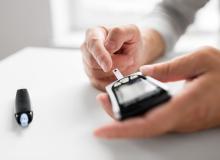In order to facilitate self-monitoring of blood glucose, many diabetic patients have purchased rapid blood glucose meters. Whether the operation is done properly is directly related to the accuracy of the test results. Take blood collection as an example. Incorrect methods or timing will affect the measurement results.
There are many types of blood glucose meters at present. Glucose meters from different manufacturers have different requirements for blood collection. Some need to insert the test strip first and then insert the blood. Some need to drip the blood first and then insert the test strip. Some require a large amount of blood. Some require a large amount of blood. Requires less blood. Drop the blood on the test paper, then insert the blood glucose meter into the blood glucose meter and wait 10 to 30 seconds before the result comes out. Patients should be proficient in operating a blood glucose meter.
Some blood glucose meters are measured after bleeding is inserted into the blood glucose meter. If you wait too long before inserting the blood glucose meter after blood dripping, the machine will display an error message, and some machines may automatically shut down. If the amount of blood taken during the test is insufficient, especially for the elderly and children, it is often difficult to get enough blood from their fingers, which will lead to test failure or low value results. In this case, the test strip needs to be replaced and the test is repeated, or Choose a model that requires less blood volume to monitor blood sugar.

